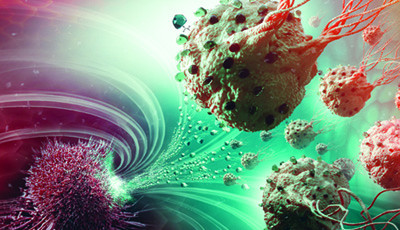Nanobots vs. cancerous tumors
October 25, 2016
on
on

Nanobots capable of navigating the blood system to administer precision doses of medicine when they encounters active cancerous tumor cells are now no longer the stuff of science fiction. Once they are usable on humans, they will allow an increase in the efficacy of highly toxic medicines on the cells to be destroyed, while considerably reducing their effects on healthy tissue. The doses may be appreciably reduced.
This has been shown (on mice) by researchers at the Nanorobotics Laboratory at the Polytechnique Montréal under the direction of Professor S. Martel, who has launched a cloud of nanorobotic agents to assault tumors. More than 100 million flagellated (autopropulsive) bacteria, loaded with medicine, take the most direct route between the point of injection and the area in the body that is to be treated, and penetrate deep into the tumors.
There, the nanorobotic agents detect hypoxic tumor zones (hypoxic = low in oxygen) and deliver their medicine there. The hypoxia is caused by the consumption of oxygen due to the rapid proliferation of the cancerous cells.
This novel use of nanotransporters* will have impacts on the creation of advanced engineering concepts and new intervention methods, but also opens the way to new directions in medicine, imaging and diagnostics.
* In the media kit downloadable on this page is a video impression illustrating the use of clouds of nanorobots
This has been shown (on mice) by researchers at the Nanorobotics Laboratory at the Polytechnique Montréal under the direction of Professor S. Martel, who has launched a cloud of nanorobotic agents to assault tumors. More than 100 million flagellated (autopropulsive) bacteria, loaded with medicine, take the most direct route between the point of injection and the area in the body that is to be treated, and penetrate deep into the tumors.
There, the nanorobotic agents detect hypoxic tumor zones (hypoxic = low in oxygen) and deliver their medicine there. The hypoxia is caused by the consumption of oxygen due to the rapid proliferation of the cancerous cells.
Bacteria with a compass
These bacteria are equipped with a compass, obtained by synthesizing a chain of magnetic nanoparticles, which allows them to move in the direction of a magnetic field, and an oxygen sensor keeps them in the area of a tumor. By exposing these bacteria to a magnetic field controlled by a computer, these researchers have demonstrated that they can perfectly imitate artificial nanobots of the future which have been foreseen for this type of mission.This novel use of nanotransporters* will have impacts on the creation of advanced engineering concepts and new intervention methods, but also opens the way to new directions in medicine, imaging and diagnostics.
* In the media kit downloadable on this page is a video impression illustrating the use of clouds of nanorobots
Read full article
Hide full article



Discussion (1 comment)
David Ashton 8 years ago